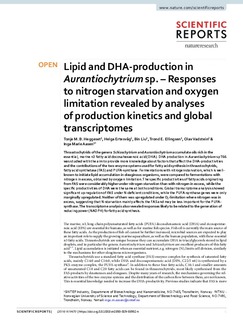| dc.contributor.author | Heggeset, Tonje Marita Bjerkan | |
| dc.contributor.author | Ertesvåg, Helga | |
| dc.contributor.author | Liu, Bin | |
| dc.contributor.author | Ellingsen, Trond Erling | |
| dc.contributor.author | Vadstein, Olav | |
| dc.contributor.author | Aasen, Inga Marie | |
| dc.date.accessioned | 2020-01-06T08:12:26Z | |
| dc.date.available | 2020-01-06T08:12:26Z | |
| dc.date.created | 2020-01-03T08:52:12Z | |
| dc.date.issued | 2019 | |
| dc.identifier.citation | Scientific Reports. 2019, 9 (19470) | nb_NO |
| dc.identifier.issn | 2045-2322 | |
| dc.identifier.uri | http://hdl.handle.net/11250/2634903 | |
| dc.description.abstract | Thraustochytrids of the genera Schizochytrium and Aurantiochytrium accumulate oils rich in the essential, marine n3 fatty acid docosahexaenoic acid (DHA). DHA production in Aurantiochytrium sp T66 was studied with the aim to provide more knowledge about factors that affect the DHA-productivities and the contributions of the two enzyme systems used for fatty acid synthesis in thraustochytrids, fatty acid synthetase (FAS) and PUFA-synthase. Fermentations with nitrogen starvation, which is well-known to initiate lipid accumulation in oleaginous organisms, were compared to fermentations with nitrogen in excess, obtained by oxygen limitation. The specific productivities of fatty acids originating from FAS were considerably higher under nitrogen starvation than with nitrogen in excess, while the specific productivities of DHA were the same at both conditions. Global transcriptome analysis showed significant up-regulation of FAS under N-deficient conditions, while the PUFA-synthase genes were only marginally upregulated. Neither of them was upregulated under O2-limitation where nitrogen was in excess, suggesting that N-starvation mainly affects the FAS and may be less important for the PUFA-synthase. The transcriptome analysis also revealed responses likely to be related to the generation of reducing power (NADPH) for fatty acid synthesis. | nb_NO |
| dc.language.iso | eng | nb_NO |
| dc.publisher | Nature Research | nb_NO |
| dc.rights | Navngivelse 4.0 Internasjonal | * |
| dc.rights.uri | http://creativecommons.org/licenses/by/4.0/deed.no | * |
| dc.title | Lipid and DHA-production in Aurantiochytrium sp. – Responses to nitrogen starvation and oxygen limitation revealed by analyses of production kinetics and global transcriptomes | nb_NO |
| dc.type | Journal article | nb_NO |
| dc.type | Peer reviewed | nb_NO |
| dc.description.version | publishedVersion | nb_NO |
| dc.source.volume | 9 | nb_NO |
| dc.source.journal | Scientific Reports | nb_NO |
| dc.source.issue | 19470 | nb_NO |
| dc.identifier.doi | 10.1038/s41598-019-55902-4 | |
| dc.identifier.cristin | 1765574 | |
| dc.relation.project | Norges forskningsråd: 227005 | nb_NO |
| dc.relation.project | Norges forskningsråd: 269432 | nb_NO |
| dc.description.localcode | Open Access This article is licensed under a Creative Commons Attribution 4.0 International License, which permits use, sharing, adaptation, distribution and reproduction in any medium or format, as long as you give appropriate credit to the original author(s) and the source, provide a link to the Creative Commons license, and indicate if changes were made. The images or other third party material in this article are included in the article’s Creative Commons license, unless indicated otherwise in a credit line to the material. If material is not included in the article’s Creative Commons license and your intended use is not permitted by statutory regulation or exceeds the permitted use, you will need to obtain permission directly from the copyright holder. To view a copy of this license, visit http://creativecommons.org/licenses/by/4.0/. | nb_NO |
| cristin.unitcode | 194,66,15,0 | |
| cristin.unitname | Institutt for bioteknologi og matvitenskap | |
| cristin.ispublished | true | |
| cristin.qualitycode | 1 | |

